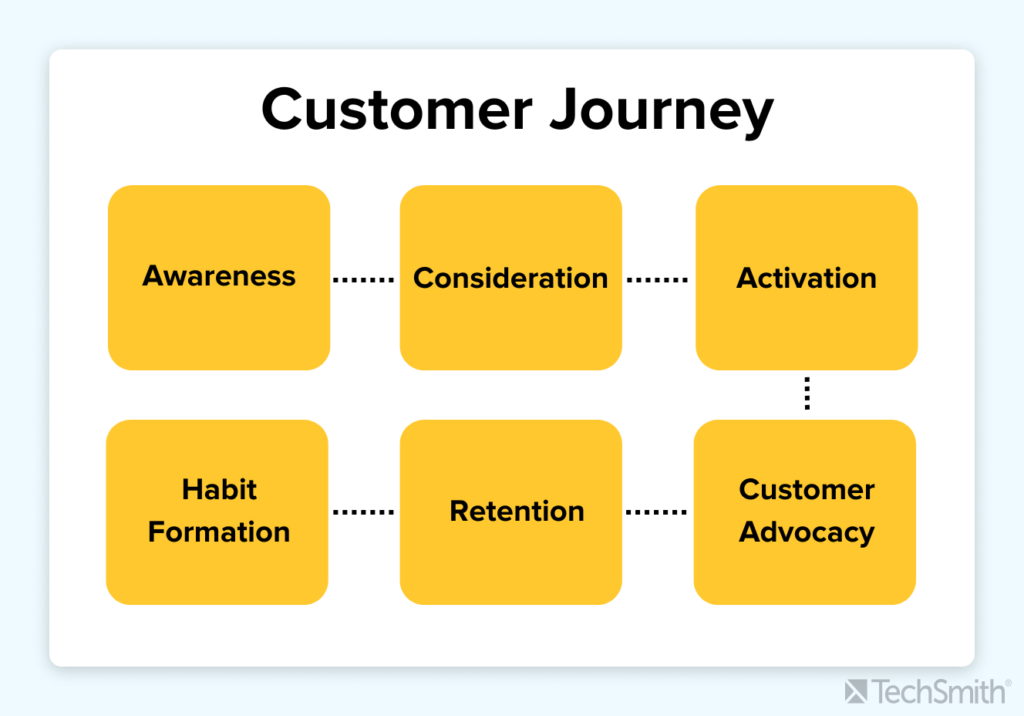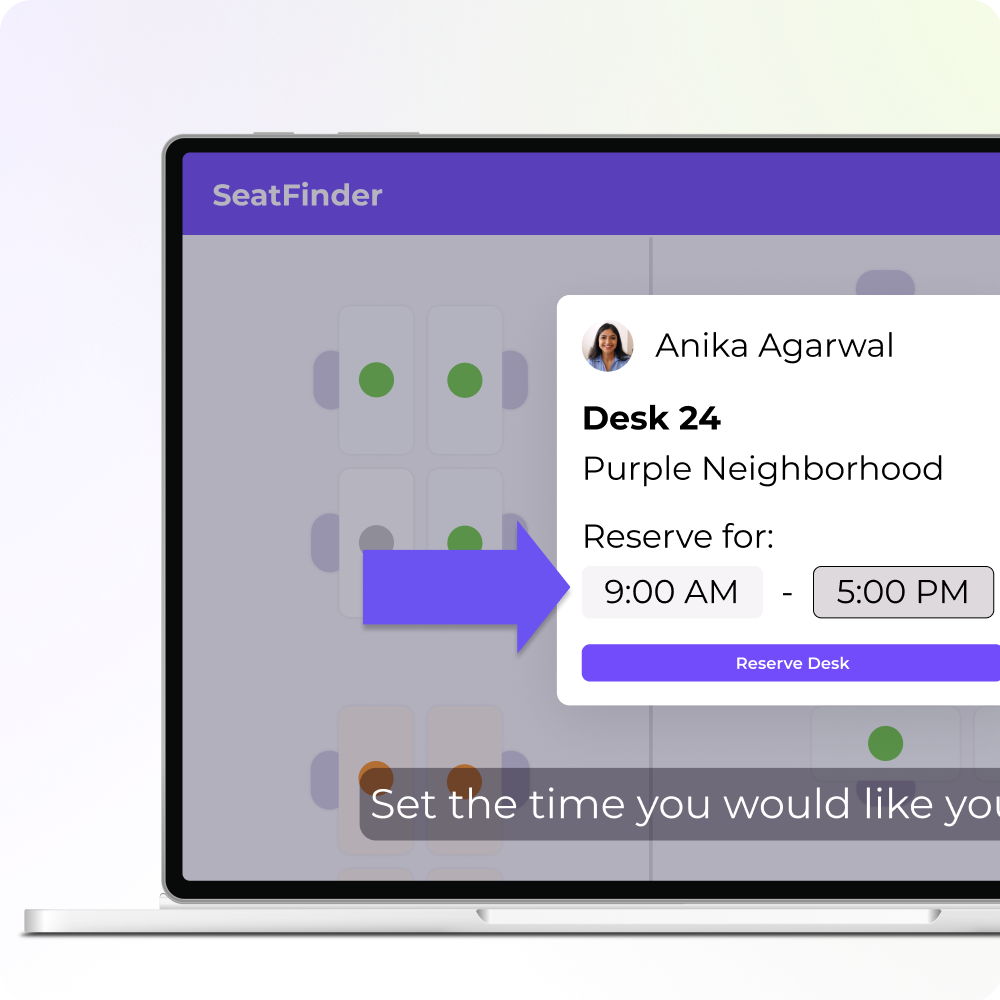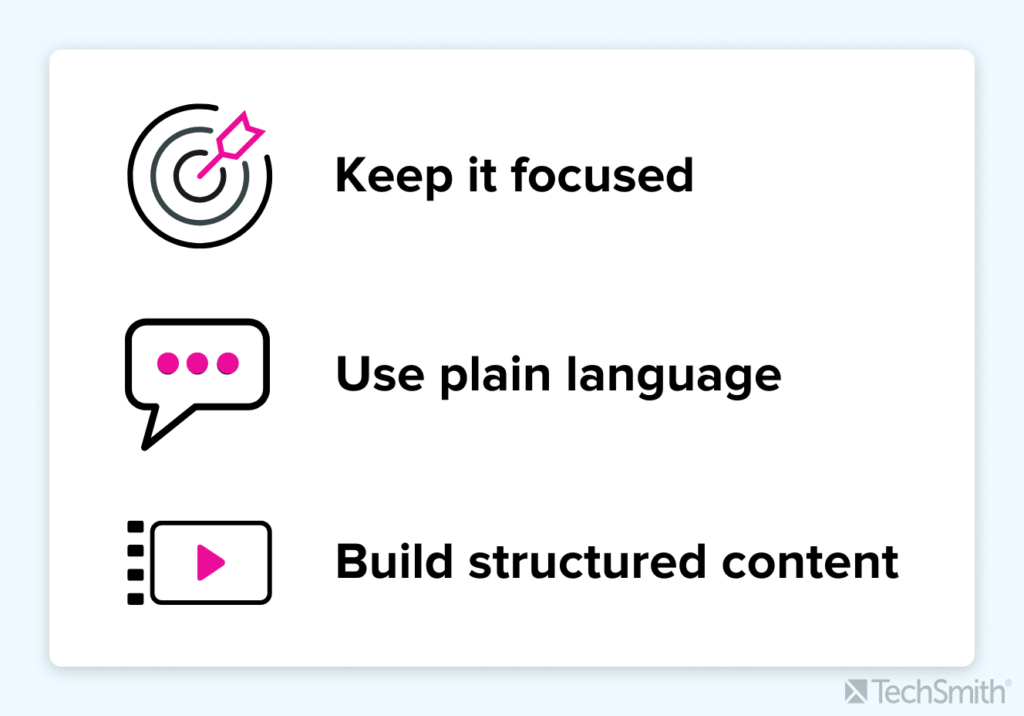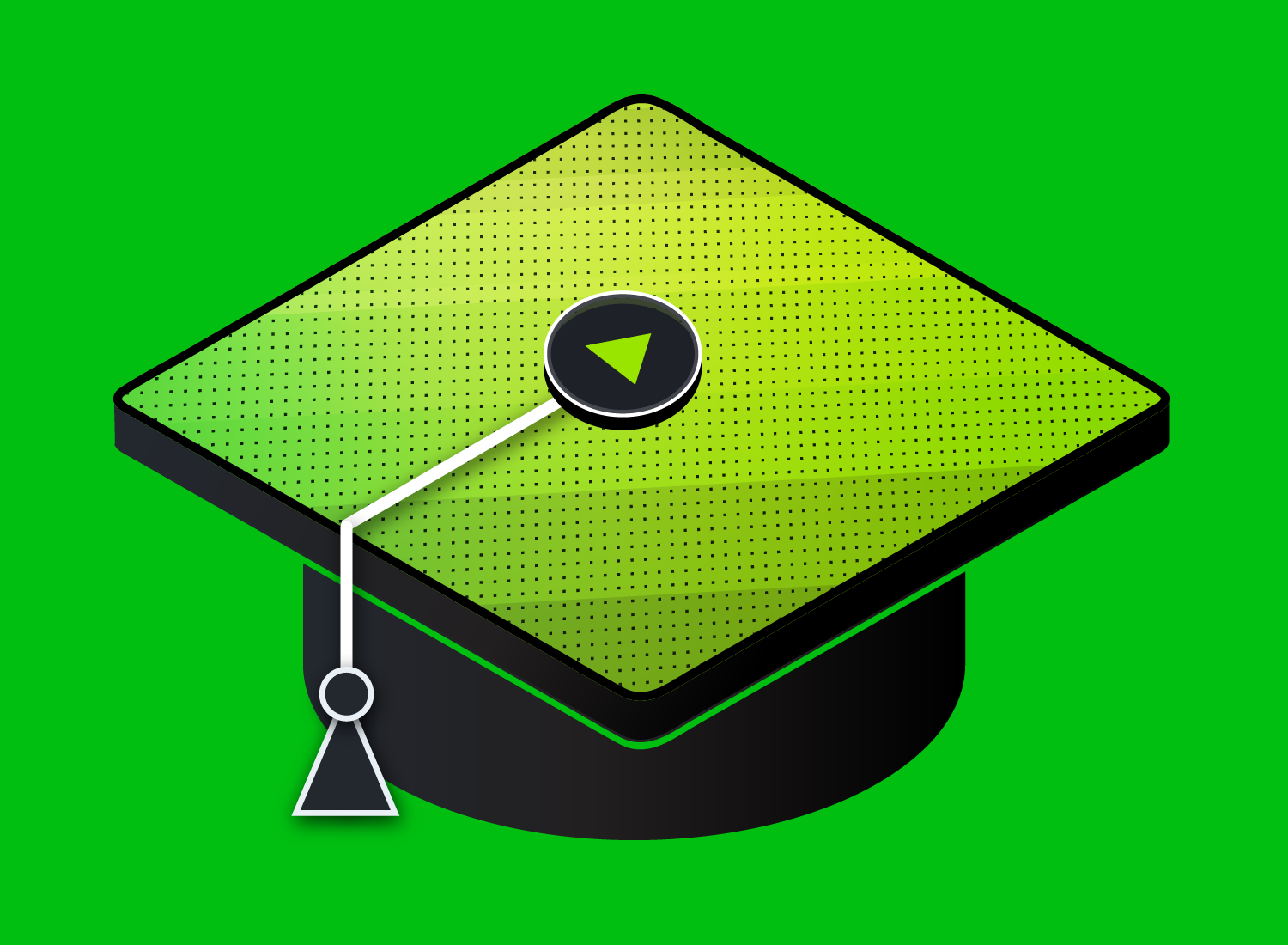Training programs help internal stakeholders improve job-related skills.
Customer education programs help customers maximize the value of your service.
Building a strategic customer education program requires careful thought, including:
- Business goals
- Target audience
- Learning objectives
- Content creation
- Delivery methods
- Evaluation approach
First, let’s cover business benefits.
Benefits of customer education programs
A successful customer education program benefits businesses and customers by enhancing the user experience, reducing friction, and fostering long-term commitment.
You can make a business case for investment in customer education by considering a few outcomes. First, customer education can increase customer retention and upsell opportunities. It can also increase loyalty and referral rates, increasing the customer base. Lastly, comprehensive customer education reduces support costs in the long run.
There are six steps to developing a comprehensive and successful program.
Step 1: Evaluate your business goals
Customer education teams ensure customers’ success with a product or service throughout their journey. Consider which parts of the customer journey are most important for your business goals.
Design your training content to match your business goals for each phase of the customer lifecycle. Education strategies may vary for each phase and business goal.
Consider the customer journey
The customer journey is outlined in these six steps:
- Awareness: The user learns about the product (e.g., search, ads, or word-of-mouth).
- Consideration: The user tries the product or service.
- Activation: The user sees the initial value and purchases.
- Habit Formation: Customers find value, forming usage habits.
- Retention: The customer renews their subscription or stays active with the product.
- Customer Advocacy: Satisfied customers see ongoing value and become loyal advocates.

Of course, no customer journey is identical; however, these steps are valuable resources to refer back to when evaluating where certain customers stand.
Align customer education priorities with business goals
A successful customer education program begins by aligning educational content with specific business goals to achieve key outcomes. For example, increasing product adoption and usage will take a different approach than if you’re looking to improve customer retention and reduce churn.
Other common themes for business goals of customer education programs include increasing customer satisfaction and experience, driving upsell and cross-sell opportunities, and increasing market competence and brand reputation. All of these goals would in theory improve business outcomes and performance, but their approach differs vastly.
Now, you may be thinking to yourself that you want all of those things, and of course you do! However, it’s important to focus on a few well-thought-out business goals and maximize their impact rather than spreading your team thin by mildly focusing on everything.
Now that you have the themes of your business goals in mind it’s time to define who you’ll need to approach.
Step 2: Define your target audience
Customer education teams work closely across departments to understand the audience, user needs, and pain points. Your audience will vary depending on your business goals, so you must take the time to figure out a target audience with the rest of the team. This team can include product managers, user experience designers, the development team, researchers, and customer support teams.
Work with subject matter experts (SME) and key stakeholders to start designing and implementing your customer education solutions.
Identify your audience’s needs.
Your audience may benefit from onboarding processes or expert tips. Knowing who your audience is shapes your customer education strategy and the knowledge base you can draw from.
First, define the target audience and personas. Identify customer personas and tailor content to their needs, experience level, and use cases to make customer onboarding and education simple.
Ask yourself: What goal, need, or problem am I solving for the target user? Tailor your content to the audience’s level of knowledge, interests, and goals.
While answering that question, take the time to understand the common challenges your users face. Create content that addresses those pain points fully.
You’ll want to deliver this information in an ideal format. Determine how your customers prefer to consume information (videos, written guides, interactive webinars, etc.). Offer diverse types of content to cater to various learning preferences. No two customers are the same, so providing various learning options has a great impact.
Make great tutorial videos
Camtasia makes it ridiculously easy to make tutorial videos that keep your viewers engaged.
Free Download
Define clear learning objectives.
Your team needs to define learning objectives they can understand and carry out. First, you need to identify what you want the audience to learn. Be specific about the skills or knowledge they should gain from the customer education experience.
Foster a positive learning environment by making objectives and examples relevant to the customer. Use examples, case studies, or scenarios that resonate with your audience. Educate customers on how your product solves their specific everyday problems.
As you work through the process, map out the customer journey and experience. Step-by-step, map out what the user experiences. Document using mockups, early builds, or screenshots. This journey map identifies pain points and highlights any areas requiring support.
Stop repeat questions
Create clear videos and guides with Snagit so you only have to explain tasks once.
Try it Free
This structure will ensure your customer education plan is comprehensive, targeted, and results-driven.
Step 3: Develop engaging educational content
Creating an engaging learning experience requires balancing clear communication, visual appeal, and interactive options to keep the audience interested and help them retain information. You must understand your audience’s needs and deliver value in a way that connects and captivates attention.
Create relevant and engaging content.
When creating educational content, there needs to be a balance between learning and engagement. Customers need to want to participate in the program.
Quality is the first step. Include high-quality audio and visuals to enhance comprehension and engagement. Visuals can serve to illustrate key points through screen recordings, real-life footage, and animations.
Start by building educational content in short, focused lessons like quick video tutorials or tips. These bite-sized pieces, known as microlearning, will keep your viewers’ attention.
As you build out your content, tell a story. Use examples and stories to frame the content around real-world scenarios. This makes the material more relatable and memorable. By using a positive tone and avoiding jargon or dull, long narration, you can ensure that users don’t grow distanced from your content.
Consider the tell-show-do approach:
- Tell: Explain the concept and what the audience will learn.
- Show: Demonstrate using visuals or practical examples.
- Do: Encourage viewers to apply what they’ve learned with exercises
Also, adding interactive elements like quizzes, sample projects, or captions can boost comprehension and engagement. You can turn those interactive elements into games by implementing rewards, badges, certifications, points, leaderboards, or challenges to motivate continued learning.
Now, you need to position your content to appear to the user at the correct time. Offer content customers can access when needed, such as in-app tooltips or quick reference guides.
Once the educational session is completed, direct viewers to the next step, such as exploring related resources or a summary of the key points to reinforce learning. Encourage comments, questions, and sharing to build a community around your content.
Tell-show-do approach:
Use Camtasia to create tutorial videos.
Camtasia makes creating engaging videos, tutorials, and product walkthroughs easy with these features:
- Quality audio
- Dynamic visuals
- Interactive elements
- Visual storytelling
Make great tutorial videos
Camtasia makes it ridiculously easy to make tutorial videos that keep your viewers engaged.
Free Download
Step 4: Choose the right delivery method
A key aspect of customer education is delivering content at crucial moments in the customer’s workflow.
To ensure success, the key is delivering the appropriate information at the right time in the customer journey.
A best practice is to deliver educational content where and when the user completes the task. This content may be in-product or quickly accessible from a website.
Leverage learning management systems
Learning management systems (LMS) can deliver educational content and track customer progress. LMS platforms allow businesses to create structured learning paths, quizzes, and assessments, ensuring customers gain the necessary knowledge.
Tip: Create SCORM content to ensure it works with most e-learning platforms and LMSs.
Offer multiple learning formats.
Not everyone learns or prefers to consume information in the same way. Make learning accessible by offering videos, articles, webinars, printed guides, and infographics.
Tip: Video generally combines two channels: audio and visuals. Studies have suggested that this is why videos contribute to improved learning performance.
Two market-leading screen recording and video editor products create content that supports a variety of learning styles. Camtasia provides SCORM features that are compatible with most LMS e-learning platforms. Camtasia creates interactive video tutorials.
Use Snagit to create visual learning aids.
Use Snagit to capture screenshots and create visual aids that make learning easier. Customers love Snagit’s ability to create step-by-step instructions and illustrated images.
Annotate and edit screenshots with Snagit
Professional mark-up tools and powerful features make it easy to create helpful images.
Try it Free
Snagit makes quick how-to images, short videos, and more!
Transform your screenshots with ready-made templates, custom themes, and unique stamps.
Step 5: Measure and improve your customer education program
To improve your customer education program, set and monitor success metrics for your content. Use tools to track content analytics, video engagement, and helpfulness, and gather customer feedback.
Gather feedback and analyze results.
Create a schedule to gather feedback and review content analytics. This helps businesses refine their educational content using current data.
Check metrics like play rate and percentage watched on your video hosting site. By monitoring what gets watched, you can tailor the content to reinforce the most watched content or improve the commonly skipped sections. Design content for specific user segments by referring to the metrics.
Add survey widgets to content pages to get direct feedback from customers. This will help your team measure how helpful the content is while the experience and information are still fresh in the user’s mind. In the same vein, you can conduct customer research and study how users interact with your product.
For more extensive revamps, try A/B testing. A/B testing refers to the practice of testing two content approaches to determine which one performs better. Try different formats, lengths, and interactive elements to see what boosts engagement.
To round out the research, use an SEO-focused program and look at customer search terms to find content gaps. Although plenty of stakeholders may have been involved in the customer education program creation process, some things simply get overlooked and that’s okay!
Continuous improvement of content and delivery
The needs of your customers and the competitive landscape are constantly changing. Make it a practice to review customer feedback and update content as products evolve regularly.
Step 6: Track the success of your customer education program
To maintain an effective customer education program, evaluate the success of your content and strategies.
Monitor key metrics
Track key performance indicators (KPIs) to assess the success of your customer education program. These metrics reveal if the program meets its goals and supports business objectives. These include:
Customer satisfaction (CSAT)
CSAT measures happiness with your product and educational content. High satisfaction indicates customers find value in both. Low satisfaction indicates that either the product, the educational content, or both need to be improved.
Customer retention
Customer retention tracks the percentage of existing customers who continue using your product over time. Effective education reduces churn by helping customers maximize product use and engagement.
Support costs
This refers to the spending amount on customer service. Good education empowers users to self-serve, reducing support tickets and costs. A decrease in basic inquiries shows that your content is effective.
Identify areas for future growth.
By tracking results, you will identify new user needs and opportunities for growth. Consider how your customer education program can evolve as your product or service offerings grow. Here are real-life examples:
- Offer training tracks for a specific user type or use case
- Include customer education in social media channels
- Provide a podcast to share best practices from experts
- Develop a certification program
Make great tutorial videos
Camtasia makes it ridiculously easy to make tutorial videos that keep your viewers engaged.
Free Download
Common mistakes to avoid in customer education
Failing to align with business goals
A successful education program addresses customer needs and the business’s strategic objectives.
Otherwise, a few common issues may appear. For example, failing to align with goals may lower customer satisfaction, reduce product adoption, reduce retention, decrease brand loyalty, and create overall low customer engagement and satisfaction.
Not to mention that efforts and budgets would be incorrectly allocated and revenue opportunities would be missed.
These fallacies make a solid business plan that much more efficient. If only one of two of these outcomes occurs, then simply tweaking the strategy may help. But, if there is a negative dip overall, it may be time to rethink the entire plan.
Customer education is a complex and nuanced process so don’t beat yourself up if you’re seeing unexpected results. Instead, be flexible and adapt to the findings to maximize the positive outcomes of the process.
Overloading customers with too much information
The customer learning experience can directly impact a customer’s perception of a product. Customers who feel confident will likely engage with your content more. Long, complicated materials can overwhelm viewers and decrease comprehension and satisfaction with your product.
Follow these best practices for content delivery:
- Keep it focused: Break content into small, digestible chunks to prevent information overload. Focus on one task or user goal per video or page.
- Use plain language: Frame headings in the customer’s language or based on the goal or action they are trying to accomplish. Clear, simple language enhances understanding and engagement.
- Build structured content: Use subheadings and lists to structure content logically. Visually break up content, keeping paragraphs short, only 1-3 lines.

Conclusion
Customer education is essential to a product’s success and to ensuring a positive customer experience. Align customer education with business goals, develop high-quality content, and steadily improve the program based on feedback.
Check out Camtasia (for training videos) and Snagit (for visuals, short videos, and documentation). TechSmith’s products are widely used in Fortune 500 customer education departments. Both products help create engaging and effective educational content that drives customer success.
Stop repeat questions
Create clear videos and guides with Snagit so you only have to explain tasks once.
Try it Free



Share